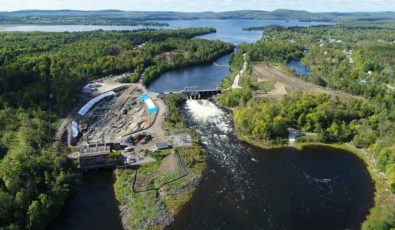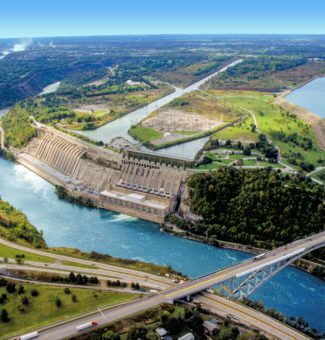Calabogie clean power project will provide more carbon-free power to Ontario
OPG’s redevelopment of the Calabogie Generating Station in eastern Ontario, currently under construction, will provide more carbon-free power for the province by efficiently using the water that is currently available on the Madawaska River.

The original, century-old powerhouse, which was damaged by a tornado in 2018 and is now out of service, will be replaced with a new, higher capacity powerhouse positioned about 50 metres upstream from the existing building.
When it goes into service in 2022, the new, two-unit station will make better use of water from the Madawaska River. The new site will allow more water to be directed through the powerhouse, doubling its capacity for clean, hydro generation from around five megawatts (MW) to approximately 10 MW, enough to power about 10,000 homes. This is because the forebay, the pool of water that feeds into the station, will be reshaped to increase efficiency.
“Rather than water going through the main dam, we’re trying to redirect as much water as possible into the powerhouse,” said Tony Palma, Project Manager at OPG. “The entire site has had to be redeveloped for this rebuild. It’s so much more than just constructing a new building. We had to make sure that all the hydraulic conditions were optimized while not altering the water levels and flows from the existing Water Management Plan on the river system.”
“The entire site has had to be redeveloped for this rebuild. It’s so much more than just constructing a new building. We had to make sure that all the hydraulic conditions were optimized.”Tony Palma, project manager
The two new operating units will handle much more water than the original station’s older units, with capacity increasing to 160 cubic metres per second (cms) compared to 66 cms. This means more water will be able to pass through the turbine generators for electricity generation.

“The water isn’t changing, but what the station looks like and how efficient it is will be changing in the grand scheme of things,” said Jordan Hughes, a Technical Officer in OPG’s Water Management office in eastern Ontario. “Ultimately, we will be able to get more clean power while maximizing the use of the water available for generation.”
Additionally, the project has realized other efficiencies by using existing infrastructure on-site as temporary dams. This has resulted in a six-month jump in construction time.
“We can start excavation immediately, and there’s quite a lot of excavation that needs to happen,” Palma said. Planned excavation on the project involves nearly 60,000 cubic metres of soil and 50,000 cubic metres of rock.
OPG is investing over $100 million to redevelop the Calabogie site, and about 175 person-years of work will be associated with the construction, boosting employment and economic benefits in the region. Through a Joint Venture, SNC Lavalin is responsible for the new station’s design while M. Sullivan & Son is leading construction.
Subscribe and stay informed
Sign up to receive the latest news, project updates, and event information from OPG.


